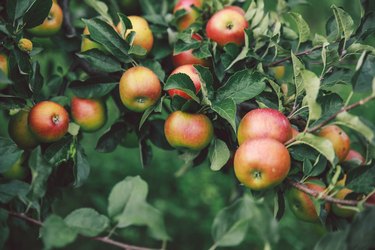
Apple trees (Malus spp.) and pear trees (Pyrus spp.) are both popular fruit trees for the home orchard. Deciding whether to grow apple or pear trees may come down to which fruit you prefer. However, though they are related (both are native to Central Asia) there are some differences between apple vs. pear trees.
Similarities Between Pears and Apples
Video of the Day
You will need to be patient when growing pears and apples. A pear tree can take anywhere from three to 10 years to produce fruit. A standard-size apple will need about eight years to produce fruit, though dwarf apple trees may start bearing fruit in as little as two to three years.
Video of the Day
Whether you are growing pears or apples, you will likely need to plant two different types of pear or two different types of apple in order to harvest fruit. That is because the majority of apple and pear trees are self-unfruitful, which means that they must be pollinated with pollen from a different variety in order to set and develop fruit.
Pear and apple trees both tend to produce more fruit than their branches can support. Therefore, you will need to thin the fruit so that there is a single apple or pear for every 6 inches of branch. This will prevent the plant from putting too much energy toward producing an excessive number of fruit and avoid branch breakage.
Pear vs. Apple Differences
When it comes to pears vs. apples, one advantage pear trees have is that their bark is stronger, and branches are less likely to break off. Pear trees also require less pruning than apple trees, though both types of trees should be pruned annually.
Harvesting time also differs between pear and apple trees. Apples should be picked once they are fully ripe. Pears, however, should be picked from the tree before they are fully ripe to prevent so-called "stone cells," which can give pears a gritty texture.
Another important difference between pear and apple trees is that the former tend to be less susceptible to diseases and pest infestations than apple trees. That means that you can grow pear trees with less worry when it comes to managing pests and spraying insecticides.
Growing Apple and Pear Trees
Both apple and pear trees grow best in soil that is slightly acidic and has a pH between 6 and 7. It is a good idea to have the soil tested prior to planting these trees. Like most fruit trees, pear and apple trees require full sun, which means at least eight hours of sunlight a day in order to thrive.
Fruit trees, including pears and apples, also have a chill hour requirement that must be met in order for them to flower and produce fruit in the spring. Chill hours are hours of exposure to temperatures between 32 and 45 degrees Fahrenheit. Though the exact number of hours varies by species and cultivar, the chill hour requirement for pears and apples is usually between 700 and 800 hours. When choosing pear or apple trees for your garden, you want to make sure that you live in a climate where winters are cold enough to meet the required chill hours.
- University of Minnesota Extension: Growing Pears in the Home Garden
- University of Maryland Extension: Training and Pruning Apple and Pear Trees
- South Dakota State University Extension: Picking and Storing Apples and Pears
- University of Minnesota Extension: Growing Apples in the Home Garden
- University of Nevada, Reno: Getting Started with Backyard Fruit Trees in Northern Nevada
- Oregon State University Extension Service: Fruit Thinning